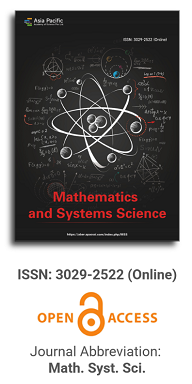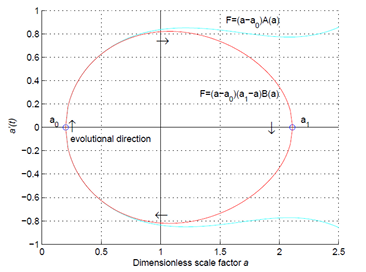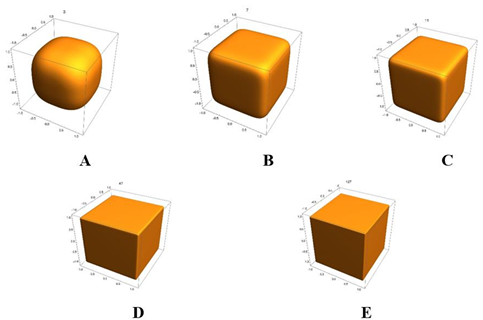


Effects of solar sail and various perturbations under the equilateral triangular configuration in the four interacting bodies problem
Vol 3, Issue 2, 2025
Download PDF
Abstract
Keywords
References
1. McInnes CR, Simmons JFL. Solar sail halo orbits I: Heliocentric case. J. Spacecr. Rockets. 1992; 29(4): 466–471. 2. McInnes CR, Simmons JFL. Solar sail halo orbits II: Geocentric case. J. Spacecr. Rockets. 1992; 29(4): 472–479. 3. McInnes CR, McDonald AJC, Simmons JFL, MacDonald EW. Solar sail parking in restricted three-body system. J. Guid. Control Dyn. 1994; 17(2): 399–406. 4. McInnes A. Strategies for Solar Sail Mission Design in the Circular Restricted Three-Body Problem [Master’s thesis]. Purdue University; 2000. 5. McInnes CR, MacDonald M, Angelopolous V, Alexander D. GEOSAIL: Exploring the geomagnetic tail using a small solar sail. J. Spacecr. Rockets. 2001; 38(4): 622–629. 6. Macdonald M, Hughes G, McInnes C, et al. Geo-sail: An elegant solar sail demonstration mission. J. Spacecr. Rockets. 2007; 44(6): 784–796. 7. Mengali G, Quarta A, Circi C, Dachwald B. Refined solar sail force model with mission application. J. Guid. Control Dyn. 2007; 30(2): 512–520 8. Heiligers J, Mingotti G, McInnes CR. Optimal solar sail transfers between halo orbits of different sun-planet systems. Adv. Space Res. 2015; 55: 1405–1421. 9. Farrés A. Contribution to the Dynamics of a Solar Sail in the Earth-Sun System [PhD thesis]. Universitat de Barcelona; 2009. 10. Farrés A, Jorba A. Periodic and quasi-periodic motions of a solar sail around the family SL1 on the Sun-Earth system. Celest. Mech. Dyn. Astron. 2010; 107: 233–253. 11. Gong S, Li J. Solar sail heliocentric elliptic displaced orbits. J. Guid. Control. Dyn. 2014; 37(64): 2021–2025. 12. Peloni A, Ceriotti M, Dachwald B. Solar-sail trajectory design for a multiple near-Earth-asteroid rendezvous mission. J. Guid. Control Dyn. 2016; 39: 2712–2724. 13. Bosanac N, Howell K, Fischbach E. A natural autonomous force added in the restricted problem and explored via stability analysis and discrete variational mechanics. Astrophys. Space Sci. 2016; 361: 49. 14. Ragos O, Perdiou A, Perdios E. The three-body interaction effect on the families of 3D periodic orbits associated to sitnikov motion in the circular restricted three-body problem. The Journal of the Astronautical Sciences. 2020; 67: 28–58. 15. Ragos O. Short and long period periodic orbits around a stable collinear equilibrium point in the circular restricted three-body problem with a three-body interaction. New Astron. 2022; 98(1): 101900. 16. Sood R, Howell K. Solar Sail transfers and trajectory design to Sun-Earth L4, L5; Solar observations and potential Earth Trojan Exploration. The Journal of the Astronautical Sciences. 2019. 17. Miyamoto M, Nagai R. Three-dimensional models for the distributation of mass in Galaxies. Publ. Astron. Soc. Japan. 1975; 27: 533–543. 18. Singh J, Taura JJ. Motion in the generalized restricted three-body problem. Astrophys. Space Sci. 2013; 343: 95–106. doi: 10.1007/s10509-012-1225-0 19. Abouelmagd EI, El-Shaboury SM. Periodic orbits under combined effects of oblateness and radiation in the restricted problem of three bodies. Astrophys. Space Sci. 2012; 341: 331–341. doi: 10.1007/s10509-012-1093-7 20. Abozaid AA, Selim HH, Gadallah KAK, et al. Periodic orbits in the frame work of the restricted three bodies under the asteroids belt effect. Applied Mathematics and Non-linear science. 2015; 1(2): 15–34. 21. Abouelmagd EI, Alhowaity S, Diab Z, et al. On the Periodic Solutions for the Perturbed Spatial Quantized Hill Problem. Mathematics. 2022; 10(4): 614. 22. Ershkov S, Abouelmagd EI, Rachinskaya A. Perturbation of relativistic effect in the dynamics of test particle. Journal of Mathematical Analysis and Applications. 2023; 524(1): 127067. 23. Doshi MJ, Pathak NM, Abouelmagd EI. Periodic orbits of the perturbed relative motion. Advances in Space Research. 2023; 72(6): 2020–2038. 24. Alshaery AA, Abouelmagd EI. Analysis of the spatial quantized three-body problem. Results in Physics. 2020; 17: 103067. 25. Jiang IG, Yeh LC. On the Chermnykh-like problem: I. The mass parameter µ = 0.5. Astrophysics and space science. 2006; 305: 341–348. 26. Jiang IG, Yeh LC. On the Chermnykh-like problem: II. The equilibrium points. Astrophysics and space science. 2006; 306: 189–200. 27. Ansari AA. The circular restricted four- body problem with triaxial primaries and variable infinitesimal mass. Applications and Applied Mathematics: An International Journal. 2018; 13(2): 818–838. 28. Ansari AA, Prasad SN. Generalized Elliptic Restricted Four-Body Problem with Variable Mass. Astron. Lett. 2020; 46: 275–288. doi: 10.1134/S1063773720040015 29. Ansari AA. Kind of Robe’s restricted problem with heterogeneous irregular primary of N-layers when outer most layer has viscous fluid. New Astronomy. 2020; 83. doi: 10.1016/j.newast.2020.101496 30. Ansari AA, Abouelmagd EI. Variable mass motion in the Hénon-Heiles system. Modern Physics Letters A. 2021; 36(21). 31. Ansari A, Kellil R, Sahdev S. Numerical exploration of the variable mass test particle on the perturbed cr3b configuration. New Astronomy. 2022; 97(11): 101885. 32. Ansari AA. Kerr-like oblate heterogeneous primaries in PCRFB problem with variable mass infinitesimal body. Modern Physics Letters A. 2024; 39(4). 33. Albidah AB, Ansari AA. Shapes and mass variation effects of the bodies in the generalized elliptic restricted 3-body problem. Astronomy reports. 2023; 67(4): 393–403. 34. Albidah AB, Abdullah. Halo orbits under some perturbations in the cr3b problem. Symmetry. 2023; 15: 418. 35. Bouaziz F, Ansari AA. Perturbed Hill’s problem with variable mass. Astron. Nachr. 2021. doi: 10.1002/asna.202113870 36. Bhatnagar KB, Hallan PP. Effect of perturbations in the coriolis and centrifugal forces on the stability of libration points in the restricted problem. Celest. Mech. Dyn. Astron. 1978; 18: 105–112. 37. Kushvah BS. Linear Stability of equilibrium points in the generalized photogravitational Chermnykh’s problem. Astrophy. Space Sci. 2008; 318(2): 41–50. doi: 10.1007/s10509-008-9898-0 38. Kumari R, Kushvah BS. Stability regions of equilibrium points in restricted four-body problem with oblateness effects. Astrophy. Space Sci. 2014; 349(2): 693–704. 39. Farrés A, Heiligers J, Miguel N. Road map to L4 /L5 with a solar sail. Aerospace Science and Technology. 2019; 95: 105458. 40. Albidah AB, Ansari AA, Kellil R. Interaction of 3-body in the circular restricted problem with variable mass. Astronomy and computing. 2023; 42. doi: 10.1016/j.ascom.2023.100688 41. Abouelmagd EI, Ansari AA. The motion properties of the infinitesimal body in the framework of bicircular Sun perturbed Earth–Moon system. New Astronomy. 2019; 73: 101282.
Supporting Agencies
Solar sail; oblateness; interactions; asteroids belts; equilateral triangular configuration;
Copyright (c) 2025 Author(s)
License URL: https://creativecommons.org/licenses/by/4.0/
Editor-in-Chief

Prof. Youssri Hassan Youssri
Cairo University, Egypt
Asia Pacific Academy of Science Pte. Ltd. (APACSCI) specializes in international journal publishing. APACSCI adopts the open access publishing model and provides an important communication bridge for academic groups whose interest fields include engineering, technology, medicine, computer, mathematics, agriculture and forestry, and environment.


.jpg)

.jpg)
